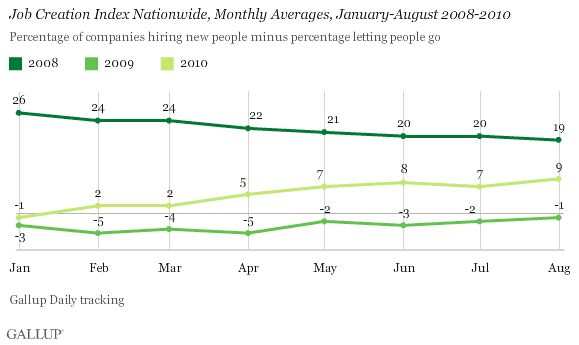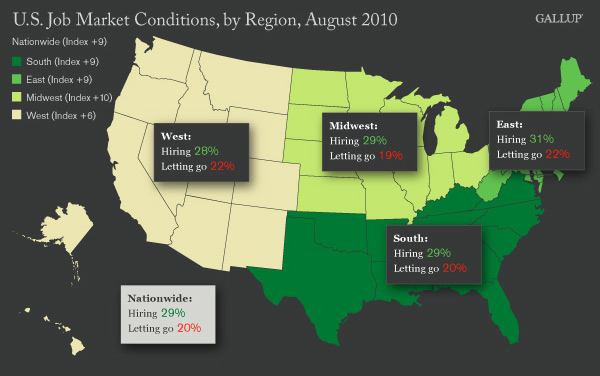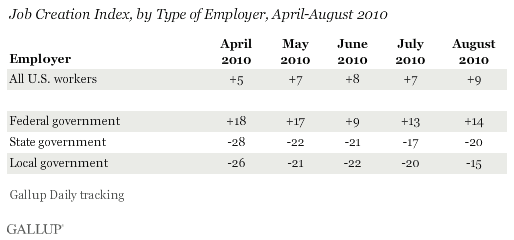PRINCETON, NJ -- Gallup's Job Creation Index increased slightly to +9 in August from +7 in July and +8 in June. Current job market conditions are better than the -1 at this time a year ago but remain below the +19 found in the same month in 2008.

Job Market Perceptions Best in the Midwest, Worst in the West
In every region of the country, more employees report that their companies are hiring than say they are letting people go. Job perceptions are best (+10) and most improved in the Midwest -- up three percentage points from July, probably reflecting continuing relative strength in U.S. manufacturing. The South no longer leads in job conditions, as it has for most of 2010, having deteriorated slightly in July and August compared with June -- possibly due to the job fallout associated with the Gulf oil spill. Job perceptions are worst in the West (+6) -- although up one point from July -- as this part of the nation continues to struggle with the fallout of the housing debacle.

High Levels of Federal Hiring Continue
Gallup's Job Creation Index shows that many more federal employees say the federal government (+14) is hiring, as opposed to letting people go. On the other hand, state (-20) and local (-15) government employees report just the reverse. This trend has persisted over several months.

Commentary
Friday's unemployment rate increase to 9.6% was in the range Gallup projected, based on its underemployment and Job Creation Index measures. At the same time, private-sector job growth was a little better than economists expected (+67,000). This is consistent with the slight uptick in the Job Creation Index, particularly given that this Gallup measure is not seasonally adjusted. While today's job situation continues to be unusually hard to discern due to the hiring and termination of government census takers, it seems clear that not enough new jobs are being created right now to keep the unemployment rate from getting worse.
Regardless, the real measure of the nation's job situation is underemployment. Gallup's underemployment measure worsened to 18.6% in August, with the government's version showing a similar deterioration. A significant reduction in underemployment is essential if the U.S. economy is to achieve a sustainable recovery in 2011.
This week, the president and his economic team are scheduled to put forth new proposals to increase U.S. job creation and economic growth. Key to their choice of them should be the proposals' ability and likelihood to significantly reduce underemployment in a reasonable amount of time -- something no one is forecasting right now.
Gallup.com reports results from these indexes in daily, weekly, and monthly averages and in Gallup.com stories. Complete trend data are always available to view and export in the following charts:
Daily: Employment, Economic Confidence and Job Creation, Consumer Spending
Weekly: Employment, Economic Confidence, Job Creation, Consumer Spending
Read more about Gallup's economic measures.
For Gallup Daily tracking, Gallup interviews approximately 1,000 national adults, aged 18 and older, each day The Gallup Job Creation Index results are based on a random sample of approximately 500 current full- and part-time employees each day.
National results for August are based on Gallup Daily tracking interviews with 17,070 employees. For this sample, one can say with 95% confidence that the maximum margin of sampling error is ±1 percentage point. Regional results for August are based on interviews totaling more than 3,000 in each region. For each total regional sample, the maximum margin of sampling error is ±3 percentage points.
Interviews are conducted with respondents on landline telephones and cellular phones, with interviews conducted in Spanish for respondents who are primarily Spanish-speaking. Each daily sample includes a minimum quota of 150 cell phone respondents and 850 landline respondents, with additional minimum quotas among landline respondents for gender within region. Landline respondents are chosen at random within each household on the basis of which member had the most recent birthday.
Samples are weighted by gender, age, race, Hispanic ethnicity, education, region, adults in the household, cell phone-only status, cell phone-mostly status, and phone lines. Demographic weighting targets are based on the March 2009 Current Population Survey figures for the aged 18 and older non-institutionalized population living in U.S. telephone households. All reported margins of sampling error include the computed design effects for weighting and sample design.
In addition to sampling error, question wording and practical difficulties in conducting surveys can introduce error or bias into the findings of public opinion polls.
For more details on Gallup's polling methodology, visit www.gallup.com.
